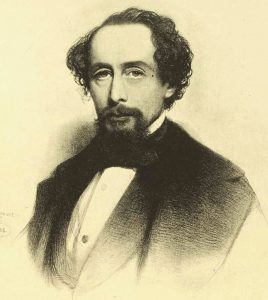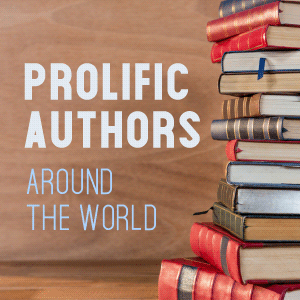Charles Dickens’ A Christmas Carol
“I have endeavoured in this Ghostly little book, to raise the Ghost of an Idea, which shall not put my readers out of humour with themselves, with each other, with the season, or with me. May it haunt their houses pleasantly, and no one wish to lay it.”
-Preface, A Christmas Carol by Charles Dickens

In the spirit of Christmas, today we’re delving into Charles Dickens’ A Christmas Carol, one of the most beloved holiday stories of all time. For those who aren’t familiar with the prolific British author, we’ll also give a brief biography of Charles Dickens.
Charles Dickens’ A Christmas Carol
Facts
- Title: A Christmas Carol
- Author: Charles Dickens
- Publication date and place: December 1843, London (Chapman & Hall)
- Word count: 28,944
- Genre: Victorian literary fiction, morality tale
Plot Summary
One of Dickens’ shorter works, A Christmas Carol is divided into five chapters, or “staves” (meaning a song stanza). The novella follows Ebenezer Scrooge, a miserable and mean-spirited old man, as he is visited by a series of ghostly apparitions. The first visit comes in form of the ghost of his dead business partner, Jacob Marley. Destined to wander the world in heavy chains, Marley comes to warn Scrooge of the afterlife that he awaits him if he does not change his hateful ways. Marley leaves after telling Scrooge that three more ghosts will appear during the following nights.
The next night, Scrooge is visited by the Ghost of Christmas Past, who ushers Scrooge back to his childhood and fills him with nostalgia and regret, especially for his choice of money over his love Belle. On the second night, the Ghost of Christmas Present comes to Scrooge, showing him the present year’s Christmas. Scrooge is taken to watch his clerk’s family’s holiday celebration and is touched by the good-hearted Tiny Tim. Scrooge wants to stay at the gathering, but instead the spirit reveals two ragged, starving children named Ignorance and Want. On the third night, Scrooge is visited by the Ghost of Christmas Yet to Come, who ultimately reveals Scrooge’s own gravesite, with scenes of Scrooge’s debtors rejoicing at this death and thieves squirreling away his riches. Scrooge is terrified and ashamed, begging to change his behavior if the ghost will change his fate.
Scrooge wakes up back in his own bed, a changed man. He upholds his vow to cherish Christmas and celebrates the holiday with Tiny Tim and his family. Scrooge’s generosity and warmth continues for the rest of his life.
Impact
A Christmas Carol was immediately critically acclaimed in England, followed shortly thereafter by America. Famous writers of the day, including William Makepeace Thackeray and John Greenleaf Whittier, heralded the novella, and edition after edition sold out. Nearly as soon as it was published, A Christmas Carol was adapted for the stage and later for film.
A very straightforward parable, A Christmas Carol asks audiences—especially those of Industrial Revolution-era Britain—to consider the lives of the poor and to be charitable to those around them, not only at Christmas but all year round. Audiences of all ages connect with Scrooge’s story of redemption, finding hope in that message that it’s never too late to change the course of your life.
The most recent film adaptation, also titled A Christmas Carol, was released in 3D in 2009. Notably, the film was largely true to Dickens’ story and even kept some of the original dialogue.
Charles Dickens Biography
Life of Charles Dickens
Charles Dickens was born on February 12, 1812 in Portsmouth, England, to a naval clerk father and aspiring educator mother. Young Charles Dickens’ family was quite poor, and his father actually went to debtor’s prison when Dickens was only 12 years old. With his father behind bars, Dickens was forced to leave school to take work at a local factory. When his father repaid his debts, Dickens was allowed to return to school, only to be removed again a few years later. Starting as an office helper, Dickens worked his way up to freelance writing and illustrating. He also married his wife, Catherine or Kate Hogarth, with whom he would go on to have 10 children.
In 1836, Dickens published his first two works: Sketches by Boz and The Posthumous Papers of the Pickwick Club. The latter serial publication was wildly popular. He then served as publisher of literary magazine Bentley’s Miscellany, in which he began to publish his first novel, Oliver Twist. Oliver Twist was critically and commercially acclaimed in both England and America.
Though his next few works were much less successful, Dickens became a celebrity after two literary tours in America. In present-day terms, his earnings reached over $1.5 million. During this time, he published A Christmas Carol and a few years later, his personal favorite David Copperfield.
In the 1850s, though, Dickens’ life took a tragic turn with the passings of his father and his daughter and a bitter separation from his wife, a grief that was clearly reflected in his writing. His next three works—Bleak House, Hard Times, and Little Dorrit—focus on the darkness and hypocrisy of humanity. From 1859 to 1861, Dickens published perhaps his two most famous novels, A Tale of Two Cities and Great Expectations.
On June 9, 1870, Charles Dickens died of a stroke, leaving his last work, The Mystery of Edwin Drood, unfinished. Dickens is buried in Poets’ Corner at Westminster Abbey.






Leave a Reply
Be the First to Comment!